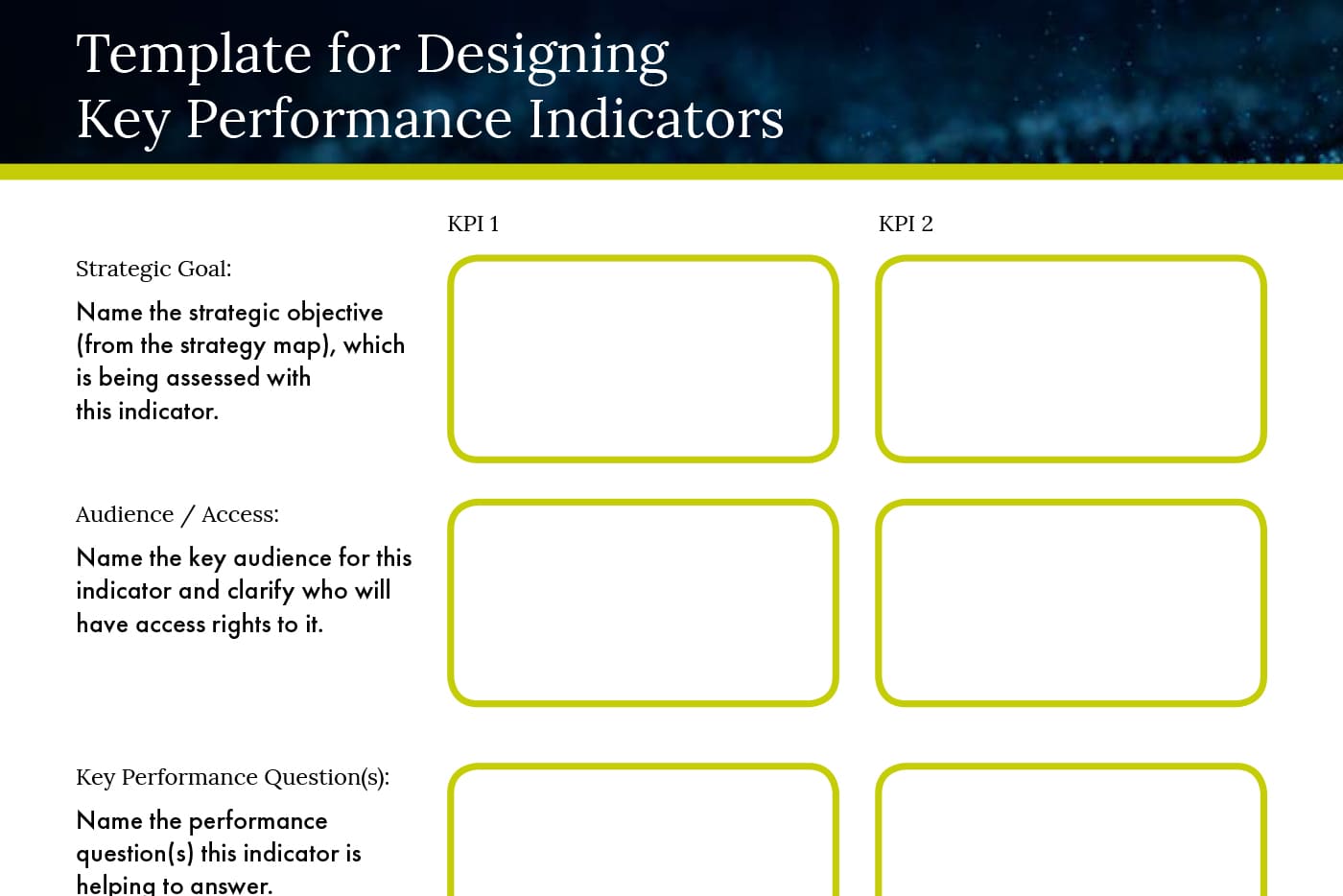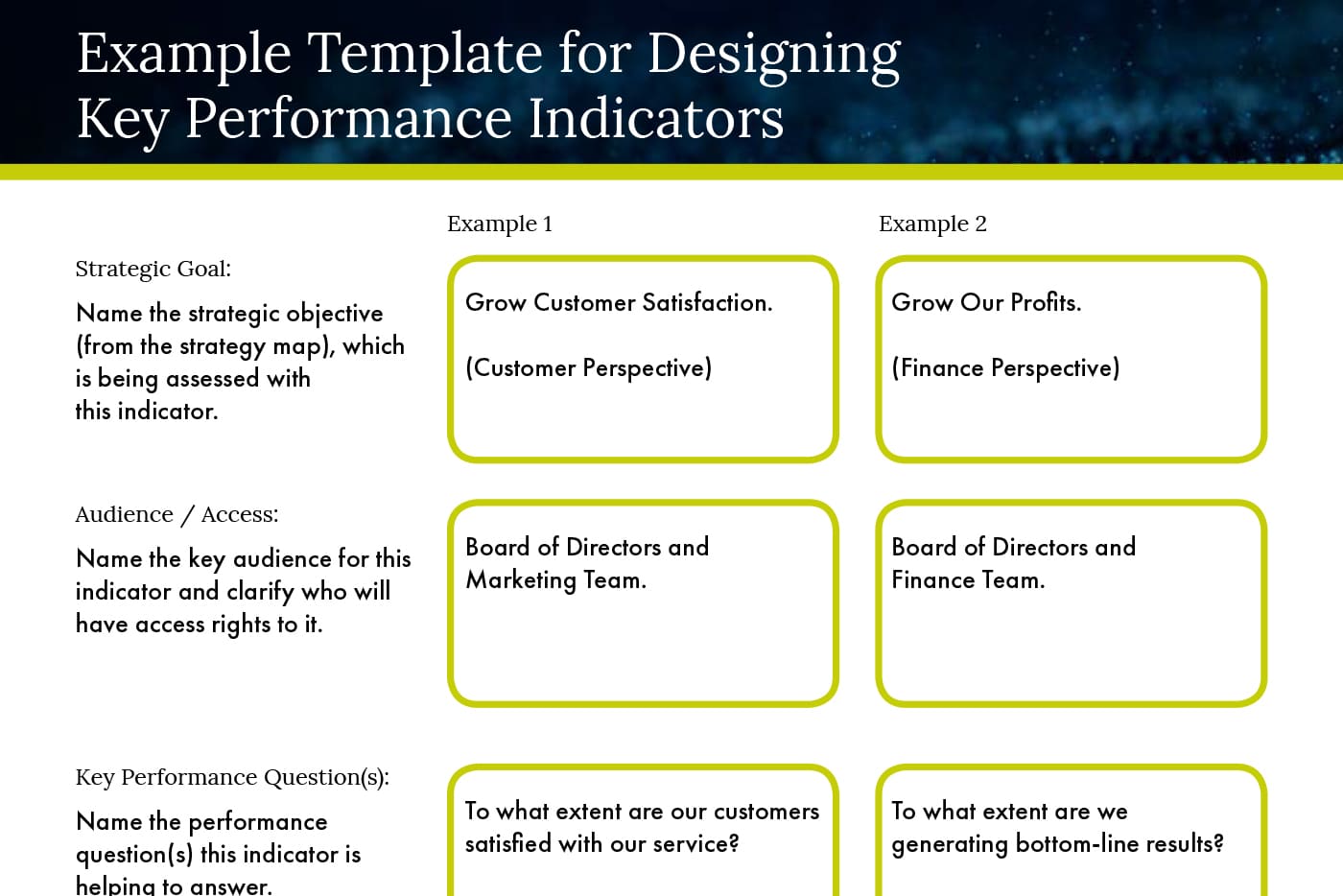A Sample KPI Template
2 July 2021
Designing your own Key Performance Indicators (KPIs) can be fraught with ambiguity and inconsistency. To help smooth the way, I’ve developed a sample KPI template that you can use when designing your own indicators. This is based on 20 years of practical experience helping companies develop relevant and meaningful business metrics and is the template I use with my clients.
What is a KPI?
The definition of a KPI is a measurement or indicator that helps an organisation understand how well it is performing in relation to its strategic goals and objectives. In short, a KPI shows whether an organisation is on track or not. KPIs also help reduce the complex nature of organisational performance to a small, manageable number of key indicators – indicators which provide insights that can, in turn, assist decision making and ultimately improve performance.
Your Key Performance Indicator Template
The first four elements of the sample KPI template address the basics of any KPI and help to put it in context. The remaining elements cover the more technical aspects of the data collection as well as some tests to ensure you have developed a sensible indicator.
You can use this sample KPI template to develop completely new KPIs or improve the effectiveness of your existing KPIs. Either way, ensure that each KPI you develop covers the following sections.
Strategic goal
It’s always best to clearly specify to which strategic objective the KPI relates, so that everyone looking at the KPI immediately appreciates its relevance.
Example: Grow customer satisfaction.
Audience and access
Here you define the primary audience for this KPI – basically, who is this data for and who will have access to it.
Example: The Board of Directors and Marketing Team.
Key Performance Question (KPQ)
Your KPI template should state the Key Performance Questions (KPQ) that the indicator is helping you to answer. This helps to provide context around why this particular KPI is being introduced and on which specific issue it is going to shed more light.
Example: To what extent are our existing customers satisfied with our service?
How will and won’t this indicator be used?
Specify how the KPI will be used so that everyone is clear about how you plan to use the information. Also define how the KPI will not be used. Sometimes, people are scared to report on measures because they fear negative results could be used against them. Here, you can say that the KPI won’t be used to determine the performance of individuals and won’t be linked to bonus payments.
Example: The indicator will be used to assess and report on our customer success internally.
It will not be used to assess performance of individuals or to determine bonus payments.
Indicator name
Every KPI needs a name so that you can discuss it collectively. Choose a name that clearly explains what the indicator is about.
Example: Net Promoter Score (NPS).
Data collection method
Your KPI template should identify and describe the data collection method you are going to use for each KPI. Data collection methods can include surveys, questionnaires, interviews, sensor data collection, focus groups, automated machine data collection as well as collection of archival data.
Example: The data will be collected using a mail-based survey.
Assessment/formula/scale criteria
Describe how performance levels will be determined. This can be qualitative, in which case the assessment criteria need to be identified, or it can be numerical or using a scale, in which case the formula or scales with categories need to be identified.
Example:Using a 0-10 scale (Not at all likely to extremely likely) participants will answer: How likely are you to recommend us to a friend?
NPS = percentage of Promoters (score 9-10) – 5 of Detractors (score 0-6).
Targets and performance thresholds
Define a target or benchmark for each indicator. Here you can also outline the performance thresholds, that is, when performance levels are judged to be good or bad.
Example: NPS of 55% by the end of 2020.
Source of data
Your KPI template should specify where the data is coming from so that people using the KPI can be assured of its reliability and validity.
Example: Survey of existing customers.
Data collection frequency
State how often the data for the KPI will be collected and coordinate the collection dates accordingly. Some KPIs require data to be collected continuously. Others specify hourly, daily, monthly, quarterly or annual collection. Make sure your schedule allows enough time to collect the data, chase people where necessary, analyse it, aggregate it, solve any issues and deliver the report while still ensuring the data it contains is as recent as possible.
Example: Monthly data collection from a sample of 10% of our customer database.
Data reporting frequency
Specify when and how often the data for the KPI will be reported. It makes sense to coordinate the data collection and reporting frequency to ensure the data you are reporting is as current and up-to-date as possible. You don’t want to end up in a situation where data is collected in January and reported at the end of the year!
Example: Monthly reporting.
Data entry (responsible person)
Your KPI template should also specify the individual or job title of the person responsible for the data collection and data updates. The owner of the KPI can be a named employee or business function, or, sometimes, an external agency.
Example: Ian Miller, Marketing Assistant.
Expiry/revision date
The key performance indicator template should always include an expiry date or revision date. KPIs are sometimes only needed for a specific period of time and without an expiry or review date these KPIs can continue indefinitely, causing unnecessary work. Even if indicators are not time- or project-specific they should be assigned a review date to ensure they remain relevant and useful.
Example: In 12months’ time.
How much will it cost?
Measurement and data collection can be expensive. It’s important to estimate the costs for collecting and monitoring an indicator and evaluate whether the costs are justified.
Example: Costs are significant but cheaper than a traditional customer satisfaction survey.
How complete is this indicator?
Your KPI template should briefly assess how well this indicator is helping to answer the associated key performance question and identify possible limitations.
Example: It provides us with a nice simple number, but the data should ideally be supplemented with unstructured customer feedback about what is particularly good and what could be improved.
Briefly describe how this indicator could influence the wrong behaviours or how people could cheat on this KPI.
Example: People could possibly influence customers before they take the survey or they could select customers who are likely to respond positively.
Here you can download the completed KPI template (PDF format) which contains two examples.
Where to go from here
If you would like to know more about KPIs and performance management, cheque out my articles on:
- How to Develop Effective KPIs
- The 10 Biggest Mistakes Companies Make With KPIs
- 6 Simple Steps To Great Key Performance Questions (KPQs)
Or browse the KPI section of this site or our KPI Library to find the metrics that matter most to you.
Related Articles
The 6 Defining Manufacturing Trends Of 2026
By now, “smart” versions exist of just about every home appliance, gadget and gizmos we can think of. However, manufacturers continue[...]
7 E-Commerce Trends That Will Transform Shopping In 2026
By now, “smart” versions exist of just about every home appliance, gadget and gizmos we can think of. However, manufacturers continue[...]
6 Critical Telecom Trends In 2026: What Industry Leaders Need To Know
By now, “smart” versions exist of just about every home appliance, gadget and gizmos we can think of. However, manufacturers continue[...]
The 7 Banking And Fintech Trends That Will Define 2026
By now, “smart” versions exist of just about every home appliance, gadget and gizmos we can think of. However, manufacturers continue[...]
Why The AI Supercycle Will Fail Without Advanced Networks
By now, “smart” versions exist of just about every home appliance, gadget and gizmos we can think of. However, manufacturers continue[...]
The Two-Tier AI Economy: Why Half Of Companies Are Being Left Behind And How To Close The Gap
By now, “smart” versions exist of just about every home appliance, gadget and gizmos we can think of. However, manufacturers continue[...]
Sign up to Stay in Touch!
Bernard Marr is a world-renowned futurist, influencer and thought leader in the fields of business and technology, with a passion for using technology for the good of humanity.
He is a best-selling author of over 20 books, writes a regular column for Forbes and advises and coaches many of the world’s best-known organisations.
He has a combined following of 4 million people across his social media channels and newsletters and was ranked by LinkedIn as one of the top 5 business influencers in the world.
Bernard’s latest book is ‘Generative AI in Practice’.












Social Media